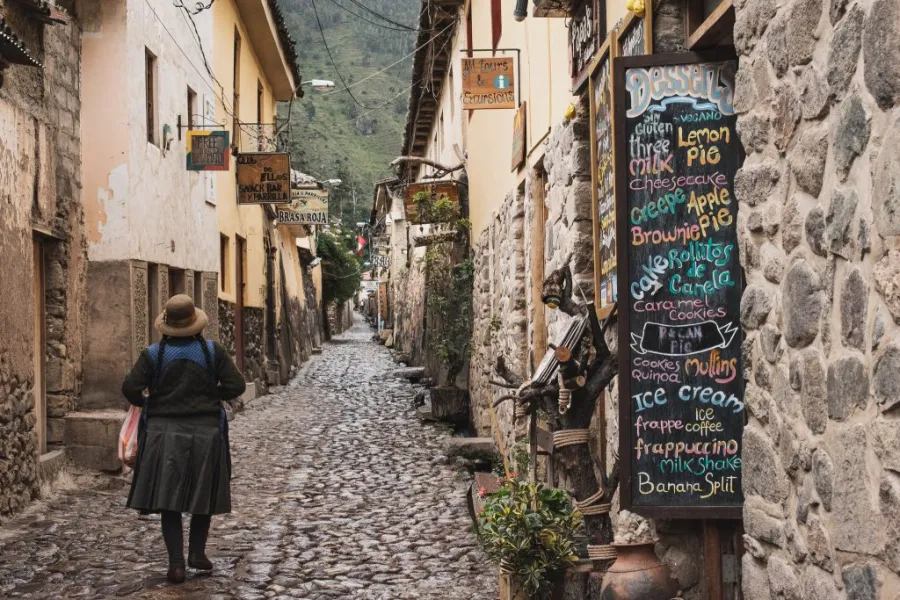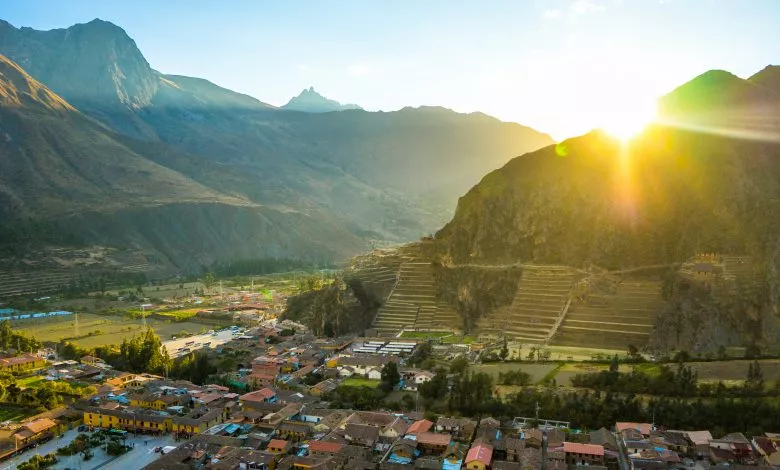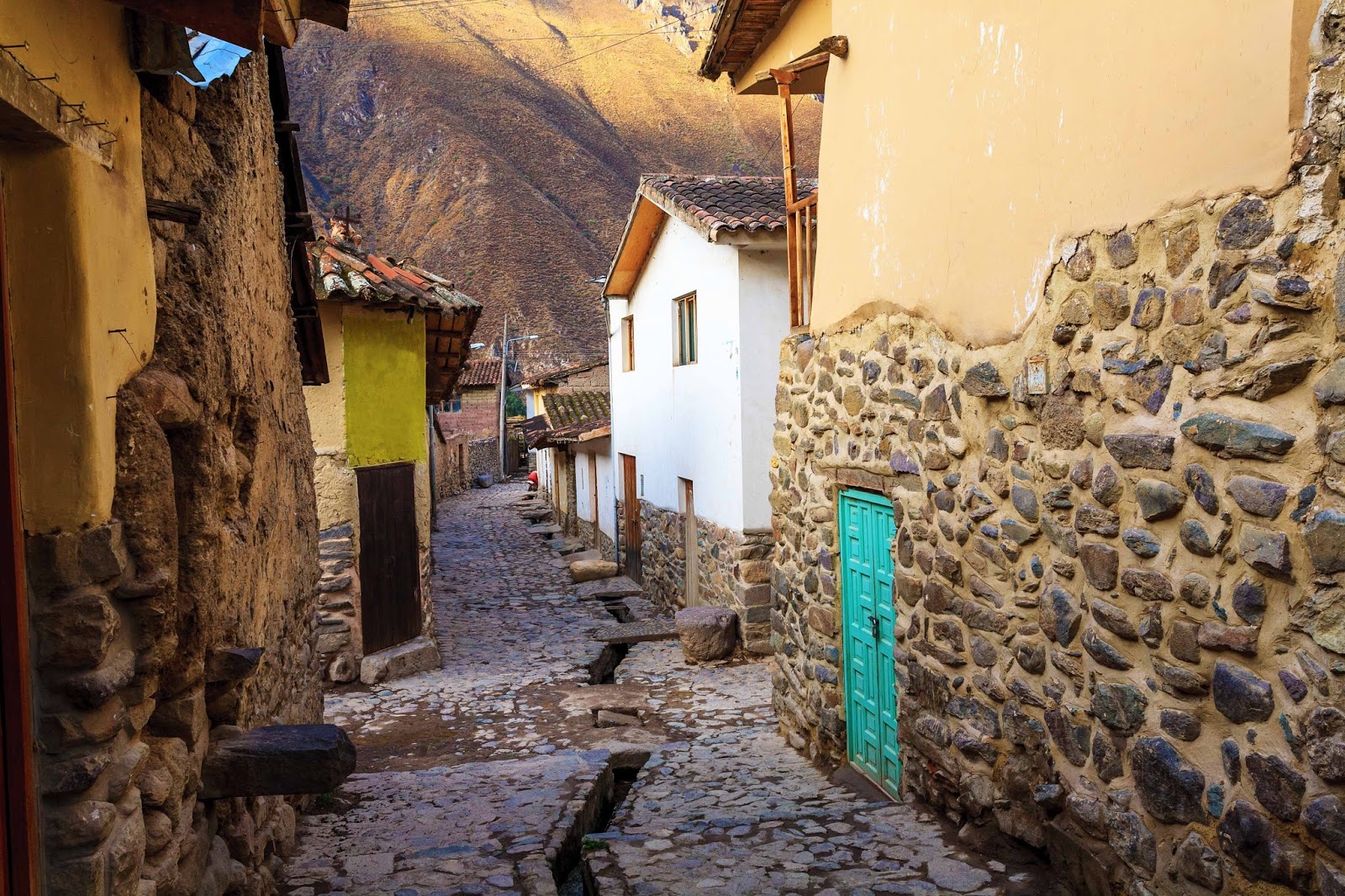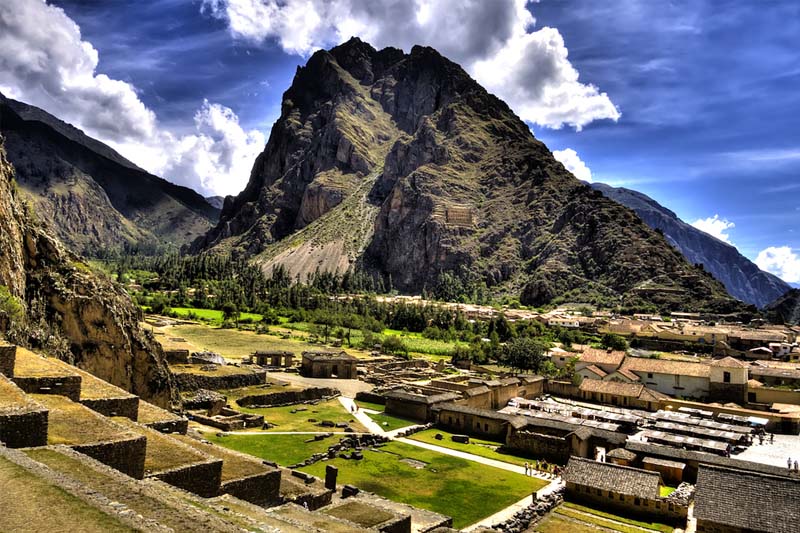Ollantaytambo, a living testimony to the ingenuity of the Inca civilization, stands as a remarkable archaeological site located within Peru’s Sacred Valley of the Incas. With its imposing terraces, meticulously crafted stone walls and intriguing temple complex, Ollantaytambo offers visitors a captivating glimpse into the ancient past of the Andean region. As one of the few remaining examples of Inca urban planning and architecture, this historic gem invites travelers to explore its rich cultural heritage and immerse themselves in the mystique of its ancient ruins.

The living streets in Ollantaytambo
Location
Ollantaytambo is located in the Sacred Valley of the Incas, in the southern region of Peru, approximately 60 kilometers northwest of the city of Cusco. At an altitude of approximately 2,792 meters above sea level (9,160 feet), Ollantaytambo offers stunning views and a captivating atmosphere amidst the Andean landscape.
A Portal to the Past
Ollantaytambo’s origins are steeped in legend and history, dating back to the 15th century when it served as a royal estate for Inca Emperor Pachacuti. The town is a masterclass in Inca engineering, with its intricately designed water channels still flowing through the streets, and the terraced ruins that guard the town standing as silent sentinels of a bygone era.
The fortress of Ollantaytambo, with its massive stone terraces, overlooks the town like a protector. Climbing the steep stone steps, visitors are rewarded not just with a panoramic view of the Sacred Valley, but with a sense of connection to the people who once called this place home. The Temple of the Sun, with its six monolithic granite blocks, showcases the Inca’s architectural brilliance and their deep reverence for the celestial.
The living history in Ollantaytambo
The city played an important role in the Inca resistance against the Spanish conquest. During the Spanish conquest of Peru, Ollantaytambo was the scene of a major battle between the Inca forces led by Manco Inca Yupanqui and the Spanish conquistadors led by Hernando Pizarro. Despite the initial success, the Incas were eventually defeated and Ollantaytambo fell under Spanish control. The layout and architecture of the city reflect its strategic importance. Its well-preserved Inca ruins.

The sunrise in Ollantaytambo
Curiosity, the city of Ollantaytambo is the scenario of the famous Inca legend of Ollantay. The legend of Ollantay tells the story of Ollantay, a brave Inca warrior who falls in love with Cusi Coyllur, the daughter of Emperor Pachacuti. Despite their love, their relationship is forbidden due to their difference in social status. Ollantay rebels against the emperor and is banished from the Inca capital, Cusco.
Ollantay gathers an army and seeks refuge in the fortress of Ollantaytambo, where he plans his rebellion against the Inca Empire. Despite facing numerous challenges and betrayals, Ollantay’s love for Cusi Coyllur drives him to fight against the emperor’s forces. The legend of Ollantay is a tale of love, courage, and sacrifice, and it is considered one of the most important literary works of the Inca civilization. The story has been passed down through generations and remains an integral part of Peruvian folklore and culture.
What can I do in Ollantaytambo?
Start with a visit to the Ollantaytambo ruins, an impressive Inca fortress with large stone terraces built into the hillside. These ruins offer a glimpse into the Inca’s architectural genius and provide stunning views of the Sacred Valley below.
Wander the Old Town
Take a stroll through the old town of Ollantaytambo, where the streets and buildings retain their original Inca layouts. This area is a living museum, offering insights into the daily lives of its ancient inhabitants.
Visit the Pinkuylluna Mountain Granaries
Hike up to the Pinkuylluna Mountain Granaries, which are Inca storehouses built on the mountainside facing the Ollantaytambo ruins. The hike is relatively short but offers fantastic views of the town and ruins.
Explore the Sacred Valley
Ollantaytambo serves as a great base for exploring the rest of the Sacred Valley. You can visit nearby archaeological sites like Moray and the Maras Salt Mines, or take a day trip to Pisac and its famous market.
Take the Inca Trail to Machu Picchu
For the adventurous, Ollantaytambo is the starting point for several treks to Machu Picchu, including the classic Inca Trail. These treks offer breathtaking scenery and a unique way to arrive at the iconic Incan citadel.
Enjoy Local Cuisine
Don’t miss the chance to try Andean cuisine in Ollantaytambo. Many local restaurants serve traditional dishes made with local ingredients, offering a taste of the region’s culinary heritage.
Participate in Local Festivals
If your visit coincides with local festivals, you’ll have the opportunity to experience Andean culture firsthand. Festivals in Ollantaytambo are colorful, lively events with traditional music, dancing, and processions.
Adventure Activities
For those seeking more adrenaline, the Sacred Valley offers activities like zip-lining, mountain biking, and white-water rafting on the Urubamba River. These activities provide unique ways to experience the valley’s stunning landscapes.
Cultural Immersion
Take the opportunity to learn more about Andean culture through immersive experiences like textile workshops, cooking classes, or visiting local communities. These activities can provide deeper insights into the traditions and ways of life in the Andes.
Ollantaytambo’s unique blend of history, culture, and natural beauty makes it a must-visit destination in Peru, offering something for every traveler.

The incredible Ollantaytambo Town
Some recommendations when you visit Ollantaytambo
- Plan your visit in advance: Research the opening hours, entrance fees and activities available in Ollantaytambo to make the most of your time there.
- Dress appropriately: The weather in Ollantaytambo can be variable, so be sure to wear comfortable, weather-appropriate clothing, including extra layers and sun protection.
- Arrive early: To avoid the crowds and enjoy the tranquility of the place, try to arrive early in the morning before the tour groups arrive.
- Explore on foot: Ollantaytambo is an ideal place to explore on foot. Walk through the town’s cobblestone streets and climb the Inca terraces for panoramic views of the valley.
- Hire a guide: Consider hiring a local guide for detailed information about the history and culture of Ollantaytambo. Guides can offer a unique and enriching perspective on the archaeological sites.
- Enjoy the local gastronomy: Take the opportunity to try the delicious Peruvian food in Ollantaytambo’s local restaurants. Many offer traditional dishes with fresh ingredients from the region.
Ollantaytambo is a living canvas, where the past and present dance in a harmony that touches the soul. Within its ancient stones lies the heartbeat of a civilization that, though vanished, continues to whisper its secrets to those who wander its sacred grounds. Here, amidst towering Andean peaks and verdant valleys, you’re not just a visitor; you become a part of a timeless narrative, experiencing the profound connection between humanity and the earth that cradled it. Ollantaytambo isn’t just a place to visit; it’s a journey back in time, a moment of awe that lingers long after you’ve left its embrace.
We hope you liked this travel blog, if you have any questions or suggestions feel free to comment! Great day to you!
Another interesting blogs:
- Some recommendations for your visit to Machu Picchu!
- Aguas Calientes: The Gateway to Machu Picchu
- Cusco: New Date for Machu Picchu Virtual Ticket Sales
- Machu Picchu weather by month

